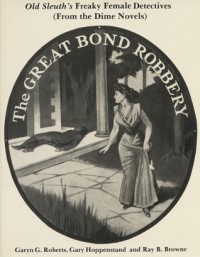Old Sleuth's Freaky Female Detectives: (from the Dime Novels)
 The dime novel detective "Old Sleuth" was the creation of Harlan Halsey and said to be the first character to use the word "sleuth" to denote a detective. Halsey's original detective, who first appeared in 1872 in the six-cent weekly Fireside Companion, wasn't elderly at all but a young man with almost superhuman abilities who liked to disguise himself as an older, bearded man. In the 1880s and 1890s, the character Old Sleuth became popular enough to warrant a separate publication of his own, and several of these issues featured female detectives front and center.
The dime novel detective "Old Sleuth" was the creation of Harlan Halsey and said to be the first character to use the word "sleuth" to denote a detective. Halsey's original detective, who first appeared in 1872 in the six-cent weekly Fireside Companion, wasn't elderly at all but a young man with almost superhuman abilities who liked to disguise himself as an older, bearded man. In the 1880s and 1890s, the character Old Sleuth became popular enough to warrant a separate publication of his own, and several of these issues featured female detectives front and center. In "Old Sleuth's Freaky Female Detectives," published 1990 by Popular Press, the editors explain the term "freaky" for these female dime novel detectives: freakish as in the usage of the day, as in someone who had unusual talents—knife throwers, trick gun marksmen—people who were both normal and abnormal. These women sleuths used an androgynous, masculine type of heroism in the stories, but at the end embrace their femininity and end their detective careers to get married. Or as the editors note, "So they [female detectives] were doubly talented; no man of the time could assume the double roles women played as detective hero—hero and weakling, masterful and subservient—or had to. Men did not have to be freaky—women did."
The stories included are:
1) Lady Kate, The Dashing Female Detective
2) The Great Bond Robbery Tracked by a Female Detective
3) Madge The Society Detective: A Strange Guest Among The Four Hundred
Both the "Lady Kate" and "Robbery" works feature a protagonist named Kate who attempt to prove the innocence of a man wrongly accused of a crime. They use disguises and end up "physically clobbering male villains left and right," thereby saving the lives and reputations of the accused men before promptly marrying the men they rescued. In the third story, "Madge" more closely resembles modern female detectives and uses her powers of deduction. Madge is described as "one of the most brilliant and clever detectives in the great metropolis" and takes on work for the money as much as the thrill. These female detective stories were popular on their own for a time, but by the end of the Great Depression, the dime novel female sleuth had virtually disappeared.



